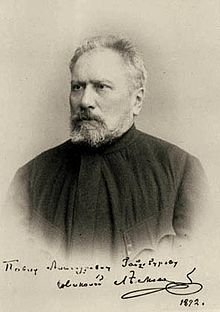The bogeyman (Nikolai Leskow)
The bugbear , also The Scarecrow and Seliwan the Forest Scare ( Russian Пугало , Pugalo ), is a Christmas story by the Russian writer Nikolai Leskow , which was published in 1885 in the magazine Saduschewnoje slowo ( Russian Задушевное слово ), an illustrated weekly paper for adolescents.
reception
Reissner wrote in 1971: “… the events” are “described from the point of view of an eight year old”… “who is not yet able to tell truth, rumor and superstition apart. Since ”he writes down“ his story ”as an adult,“ the whole thing takes on a touch of irony ”.
content
As a child, the first-person narrator cried every day after having watched from the living room window how soldiers exercising were beaten over and over again. So he felt it was a relief when his noble parents left the large Orjol town house with him and moved into a smaller house in a village in the countryside on the clean Gostomlja in the Kromy district in the summer . Far out, about six kilometers from Kromy, at the crossroads - at the fork in the road to Kiev or Fatesch - Seliwan, an orphaned baker's assistant from Kromy, had leased an empty hostel from a merchant for a hundred rubles a year. Seliwan and his sick wife, dressed in rags, lived a secluded life. Guests hardly ever got lost in the hostel. The people from Kromy couldn't explain how the innkeeper raised the rent every year.
Rumor and superstition
There was an explanation for the lease payment: Seliwan used to deal with evil . The forest spirit lived near the "terrible" inn of the "terrible robber and bloodthirsty magician" Seliwan . What's more, Seliwan had sold his soul to several devils at once. And a number of forest spirits kindled snowdrifts at dusk. Seliwan, the specter, would put a candle in the window when the storm raged. Merchants with bulging wallets and priests with paper money in their fur hats came in and were never seen again.
Grandfather Ilya had instructed the narrator in ghost lore. The eight-year-old's mother intervened against such information. But the farmer Nikolai, a nephew of grandfather Ilya, got stuck at Selivan's forest edge in such a blizzard, froze to death and the foxes had gnawed the nose and cheeks of the dead man sitting on a tree stump. And Seliwan had lured an entire noble family into his leased hostel in the snowstorm "and slowly cut off the noble children finger by finger".
The shoemaker Iwan had also met the innkeeper on the road in front of Seliwan's forest in a snowstorm blown by the forest spirits. The magician Seliwan was only vulnerable in the stomach. While Ivan nimble him the greatest and sharpest Ahle pushed into the body, to Seliwan turned into a verst pole (in something like a wooden kilometer ). In the argument with the blacksmith Sawel, Seliwan turned into a boar . It was the smith who put an end to this transformation of Seliwan into a boar with the patience of an angel: Sawel let an unbleached, knotted thread rot on the dung heap. Then the spell was broken. The cross-eyed miller's boy Savka boldly, prudently and skillfully threw a log of wood at Seliwan, who had turned in vain into a red rooster . However, Sawka's face was disfigured by horror when he reported it at home. As a sheep and a calf , Seliwan was quickly recognized and beaten. Then Seliwan lay down as a new, freshly tarred wagon wheel in the middle of the driveway. Shrewd travelers cut it to pieces. The narrator's childhood home in Kromy made Seliwan unsafe as a large, red-brown rat .
The truth
When the narrator and a couple of young people from Kromy wanted to catch Seliwan in his forest the following spring, it was the innkeeper himself who saved the life of this hunting party in the muddy bank of a river. And towards the end of the year - on Christmas Day - it was Seliwan who faithfully carried the box full of money that had been forgotten in his inn to Kromy for the aunt of the narrator.
German-language editions
- The Scarecrow. P. 133–236 in: Nikolai Lyesskow: The villain of Askalon. The Scarecrow. Two stories. Translated from the Russian by Karl Nötzel . 236 pages. Verlag Karl Alber , Freiburg 1949
- Seliwan the forest fright. Narration . Piper Munich 1956, translator: Hans Ruoff
- The bugbear. German by Ruth Hanschmann. P. 300–369 in Nikolai Leskow: The way out of the dark. Stories. 467 pages. Dieterich'sche Verlagsbuchhandlung, Leipzig 1972 (Dieterich Collection, Vol. 142, 3rd edition)
- The bugbear. Translated from the Russian by Ruth Fritze-Hanschmann. P. 165–220 in: Nikolai Leskow: Das Schreckgespenst. Stories. With book decorations by Heinrich Vogeler . 272 pages. Gustav Kiepenheuer Verlag, Leipzig and Weimar 1982 (1st edition, series: Die Bücherkiepe )
Output used:
- The bugbear. German by Wilhelm Plackmeyer. P. 218–276 in Eberhard Reissner (Ed.): Nikolai Leskow: Collected works in individual volumes. The juggler pamphalon. 616 pages. Rütten & Loening, Berlin 1971 (1st edition)
Web links
- The text
- Entry in the Laboratory of Fantastics (Russian)
- The bugbear entries in WorldCat
- The scarecrow entry in WorldCat (Verlag Georg Müller, Munich 1927)
